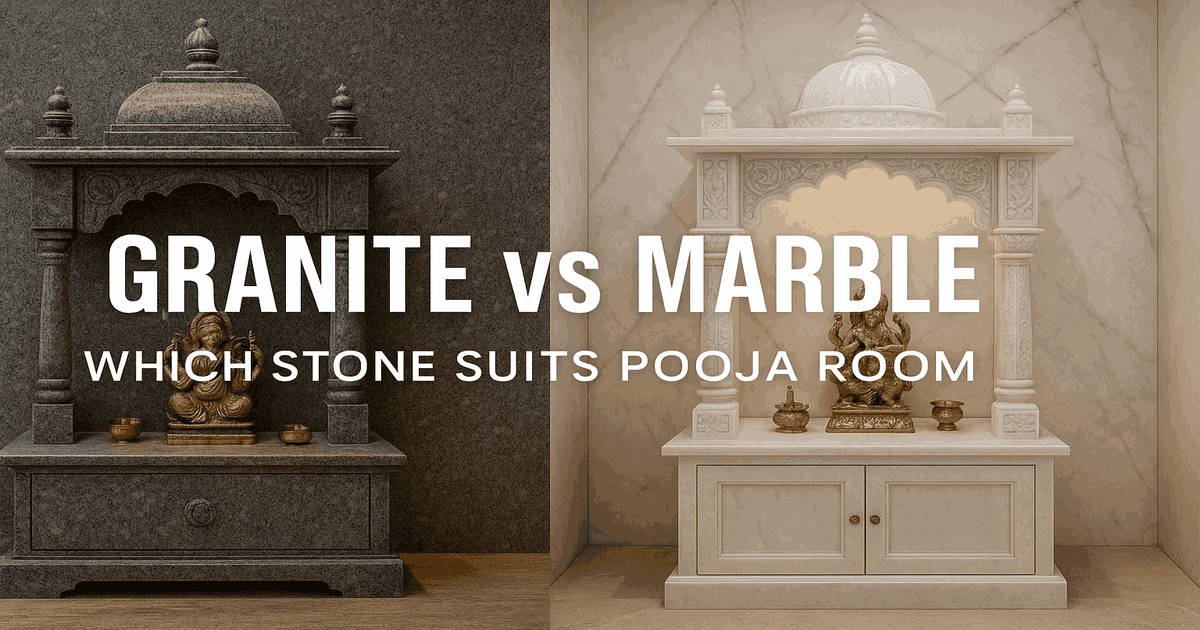
A pooja room is the most sacred part of an Indian home. It’s not just a space—it’s a spiritual sanctuary where families begin their day with prayers and positive energy. Choosing the right stone for your pooja room is vital, as it impacts both the ambience and longevity of the temple.
The question often arises: which stone is best for pooja room granite or marble? Both materials are widely used in Indian homes, but each offers distinct benefits. Let’s explore in detail and help you make the right choice for your sacred space.
Natural stone has long been associated with temples and spiritual spaces. From ancient shrines carved in marble to granite temple pillars that have lasted centuries, stone remains the most preferred choice for pooja rooms.
Here’s why choosing the right stone matters:
Marble is the best stone for pooja room if you prefer traditional elegance, spiritual purity, and artistic carvings.
Granite is the best choice if you want a long-lasting, modern, and low-maintenance pooja room.
Let’s compare the two side by side:
Feature | Marble | Granite |
Aesthetics | Elegant, bright, traditional | Sleek, bold, modern |
Durability | Strong but softer, prone to scratches | Extremely durable, highly resistant |
Maintenance | Needs sealing & polishing | Low maintenance |
Carvings | Allows detailed traditional designs | Limited carvings, more plain |
Cost | Premium pricing for high-quality marble | Generally more affordable |
Best For | Traditional, spiritual ambience | Modern, durable pooja rooms |
Final Recommendation:
While marble and granite are the most popular, other natural stones can also enhance your pooja room:
Each stone offers unique benefits depending on your home’s interiors and spiritual preferences.
At Stone World, we understand that your pooja room is a reflection of devotion and heritage. That’s why we offer:
So, which stone is best for pooja room, granite or marble?
At Stone World, we bring you the finest collection of marble and granite mandirs—crafted to perfection with devotion and artistry. Whether you want a compact wall-mounted unit or a grand carved temple, we have the right solution for your sacred space.
Explore Stone World’s exclusive range of pooja room mandirs today and choose the perfect stone that complements your devotion and home décor.
Contact us to discuss your custom pooja mandir design—we’ll help you create a divine space that lasts for generations.
Marble is best for a traditional, bright, and spiritual ambience, while granite is ideal for durability and low maintenance. The choice depends on whether you prefer intricate carvings and elegance or strength and modern appeal.
Yes, marble requires sealing and polishing to maintain its shine. It is prone to staining from oil, turmeric, and kumkum used in rituals. Regular care ensures your marble mandir retains its beauty for years.
Granite is an excellent choice for pooja mandirs. It is strong, scratch-resistant, and easy to maintain. While less traditional in appearance, it suits modern homes perfectly and lasts for generations with minimal upkeep.
High-quality marble, such as Makrana or Italian, is usually more expensive than granite. Granite offers durability at a more affordable price, making it a cost-effective option for families looking for strength and elegance together.
Yes, both marble and granite mandirs can be customised. Marble allows intricate carvings and traditional designs, while granite works well for sleek, modern styles. At Stone World, we design pooja mandirs tailored to your needs.
Granite generally lasts longer as it is harder and highly resistant to scratches and stains. Marble is durable, too, but requires more maintenance. With proper care, both stones can serve your pooja room for decades.
Yes, alternatives like sandstone, quartzite, or slate can also be used for pooja rooms. Sandstone offers earthy tones, quartzite provides durability with shine, and slate gives a rustic look. Each stone has unique advantages.